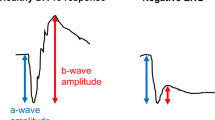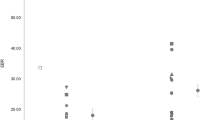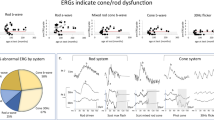Abstract
SIGNIFICANT changes in electroretinograms (ERG) and in spontaneous electrical activity recorded from the compound eyes of cockroaches have been found here during investigations of the effects of radiation on insects. These electrical discharges, although similar to the activity recorded from the optic nerve of Limulus1, do not exhibit as marked a change in frequency with light stimulation. In this communication, we present the results of preliminary studies of the effects of X-rays on both the ERG and the spontaneous electrical discharges in the eye of the cockroach B. giganteus.
This is a preview of subscription content, access via your institution
Access options
Subscribe to this journal
Receive 51 print issues and online access
$199.00 per year
only $3.90 per issue
Buy this article
- Purchase on SpringerLink
- Instant access to full article PDF
Prices may be subject to local taxes which are calculated during checkout
Similar content being viewed by others
References
Hartline, H. K., Harvey Lectures, 37, 39 (1941–42).
Roeder, K. D., Insect Physiology (Chapman and Hall, Ltd., 1953).
Author information
Authors and Affiliations
Rights and permissions
About this article
Cite this article
BALDWIN, W., SUTHERLAND, J. & HABOWSKY, J. Effects of X-rays on Electrical Activity in the Eye of the Cockroach Blaberus giganteus. Nature 199, 616 (1963). https://doi.org/10.1038/199616a0
Issue date:
DOI: https://doi.org/10.1038/199616a0



